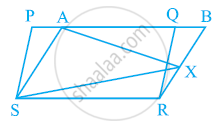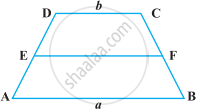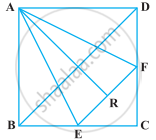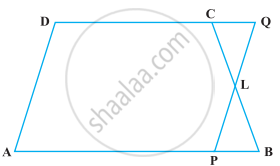Advertisements
Advertisements
प्रश्न
In the following figure, PSDA is a parallelogram. Points Q and R are taken on PS such that PQ = QR = RS and PA || QB || RC. Prove that ar (PQE) = ar (CFD).

उत्तर
Given: In a parallelogram PSDA, points Q and R are on PS such that
PQ = QR = RS and PA || QB || RC.
To prove: ar (PQE) = ar (CFD)
Proof: In parallelogram PABQ,
And PA || QB ...[Given]
So, PABQ is a parallelogram.
PQ = AB ...(i)
Similarly, QBCR is also a parallelogram.
QR = BC ...(ii)
And RCDS is a parallelogram.
RS = CD ...(iii)
Now, PQ = QR = RS ...(iv)
From equations (i), (ii), (iii) and (iv),
PQ || AB ...[∴ In parallelogram PSDA, PS || AD]
In ΔPQE and ΔDCF,
∠QPE = ∠FDC ...[Since, PS || AD and PD is transversal, then alternate interior angles are equal]
PQ = CD ...[From equation (v)]
And ∠PQE = ∠FCD ...[∴ ∠PQE = ∠PRC corresponding angles and ∠PRC = ∠FCD alternate interior angles]
ΔPQE = ΔDCF ...[By ASA congruence rule]
∴ ar (ΔPQE) = ar (ΔCFD) ...[Since, congruent figures have equal area]
Hence proved.
APPEARS IN
संबंधित प्रश्न
If E, F, G and H are respectively the mid-points of the sides of a parallelogram ABCD show that ar (EFGH) = 1/2ar (ABCD)
In the given figure, PQRS and ABRS are parallelograms and X is any point on side BR. Show that
(i) ar (PQRS) = ar (ABRS)
(ii) ar (AXS) = 1/2ar (PQRS)

A farmer was having a field in the form of a parallelogram PQRS. She took any point A on RS and joined it to points P and Q. In how many parts the field is divided? What are the shapes of these parts? The farmer wants to sow wheat and pulses in equal portions of the field separately. How should she do it?
ABCD is a parallelogram, G is the point on AB such that AG = 2 GB, E is a point of DC
such that CE = 2DE and F is the point of BC such that BF = 2FC. Prove that:
(1) ar ( ADEG) = ar (GBCD)
(2) ar (ΔEGB) = `1/6` ar (ABCD)
(3) ar (ΔEFC) = `1/2` ar (ΔEBF)
(4) ar (ΔEBG) = ar (ΔEFC)
(5)ΔFind what portion of the area of parallelogram is the area of EFG.
ABCD is a trapezium with parallel sides AB = a cm and DC = b cm (Figure). E and F are the mid-points of the non-parallel sides. The ratio of ar (ABFE) and ar (EFCD) is ______.

PQRS is a rectangle inscribed in a quadrant of a circle of radius 13 cm. A is any point on PQ. If PS = 5 cm, then ar (PAS) = 30 cm2.
ABCD is a square. E and F are respectively the mid-points of BC and CD. If R is the mid-point of EF (Figure), prove that ar (AER) = ar (AFR)

In trapezium ABCD, AB || DC and L is the mid-point of BC. Through L, a line PQ || AD has been drawn which meets AB in P and DC produced in Q (Figure). Prove that ar (ABCD) = ar (APQD)

If the mid-points of the sides of a quadrilateral are joined in order, prove that the area of the parallelogram so formed will be half of the area of the given quadrilateral (Figure).
[Hint: Join BD and draw perpendicular from A on BD.]

The diagonals of a parallelogram ABCD intersect at a point O. Through O, a line is drawn to intersect AD at P and BC at Q. Show that PQ divides the parallelogram into two parts of equal area.
